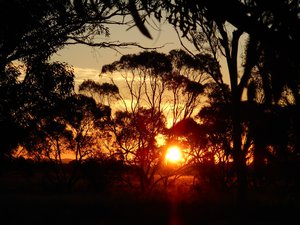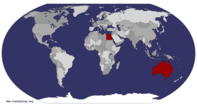Advertisement
Published: November 7th 2014

 Sunset at Peterborough
Sunset at Peterborough
This was taken just next to our camp site at Peterborough Rest Area, while listening to birds saying goodbye to the day.In the morning, we hitched up and left the caravan park but only drove as far as the Wadlata Outback Centre where we parked the whole rig and went in to finish looking at the displays in the “Tunnel of Time”.
The next section dealt with the “Tea and Sugar” train, (with the display set up in an old railway carriage) that had been vital in bringing supplies in to the outback towns. This was followed by a hands on display of the establishment and running of the Telegraph lines and offices. They even had a telegraph key that you was attached to a computer screen. It sent you a message, which appeared in words on the screen, and you had to tap out the answer using the telegraph key and the alphabet of the Morse code next to it. I had a few goes to give a really simple answer but no matter how fast I tapped it the computer couldn’t decipher what I’d said as I was too slow. It thought I’d finished a letter and put it on the screen when I was actually only halfway through the dots and dashes for one letter. It’s much harder

 A Mine Haul Pack
A Mine Haul Pack
These huge trucks are used to haul the coal (or ores) from the face to the trains or processing plants. than it looks! I don’t know how the operators were able to keep up the speed necessary all the time – it would have given me Repetitive Strain Injuries (Occupational Overuse Syndrome). It was fun trying though.
There was also an outback farm kitchen set up, complete with pedal radio for the children to do their School of the Air lessons. This is like a bicycle but with no wheels that generates the power to run the radio. When a young lad sat on it he had to pedal quite hard before the words being said over the “radio” could be understood. I’m sure the parents must have been doing the pedalling as I can’t imagine the kids being able to respond and pedal at the same time. It was ingenious and cheap but showed how difficult life was in the outback in those days. Needless to say, I didn’t have a go on this equipment!
Further along they had an old telephone switchboard with the long spring-loaded cords that you put into the holes to connect calls. I had a go and a “phone call” of two farmer’s wives talking about an upcoming event came over the

 Tom Kruse - Mailman
Tom Kruse - Mailman
Tom Kruse delivered the mail along the Birdsville Track when it was just a vague track across sand dunes. It could take up to 2 weeks, depending on conditions, and he had to carry metal half-pipes to put under the wheels to get out of the frequent bogging.speaker. That was fun, too, and brought back memories as I operated one of those switchboards more than 30 years ago during lunch breaks to relieve the receptionist while she had her lunch. It’s much more fun than just pushing buttons!
We also watched part of a very long video, “The Back of Beyond”, which showed old black and white footage of Tom Kruse delivering mail along the Birdsville Track when it was still just a track over the sand dunes. The van used to get bogged all the time so he carried some sheets of metal to place under the wheels and drive until it got bogged again and then move them forward again. He had to go back and get them once he was on firmer ground again. Sometimes he had passengers who were going to places along the track and they’d have to get out and help. The journey could take up to 2 weeks, which we could now do on the bitumen road in about 7 hours. Tom Kruse is a legend in the outback and highly respected.
Another video, “Deserts Bloom” showed the outback after rain and how it affected the animals and

 The Entrance to Wadlata Outback Experience
The Entrance to Wadlata Outback Experience
This is Akurra, a huge snake from the Aboriginal Creation Stories. He was responsible for many features of the landscape such as waterholes and gorges.plants. It also told us about the Fenced Reserve that has been funded by BHP to try and protect some of the vulnerable species of natives from feral animals, which have all been removed from the area. Foxes, cats and pigs are doing dreadful damage to the habitats and also killing these small helpless animals, many of whom are on the verge of extinction, hence the need for the reserve.
There was also a video of stories from some of the people that live in towns along the Oodnadatta Track, including one lady who has made a business out of selling Quandong products. We were happy to see someone we recognised, too. Talc Alf, whom we had met when we were doing our Lake Eyre tour in 2011, after the floods filled the Lake. He is a real character who has some rather outlandish ideas about how language and the letters of the alphabet originated but also sculpts plaques and figures in talc, the fine soft white stone that is used to make talcum powder.
The last two displays centred on mining and power. The mining display showed us underground in Roxby Downs and Olympic Dam and explained
how copper, uranium, silver and gold are mined, separated and processed, and the yields they get from the mines each year. They had one of the massive haulpacks that carry the ore away, too. Barry said they used even bigger ones at Mt Newman, where he worked in 1977!
Finally, there was a mock-up of part of the control room of the Port Augusta Power Station where ¼ of all South Australia’s electricity is produced. A coal train with 160 wagons on it comes down daily from the Leigh Creek Coalfield to deliver the fuel for the station and returns empty each night ready for the next run.
By the time we’d finished all the displays we were more than ready for a break and some lunch which we enjoyed in the Tourist Centre café along with some very welcome iced coffees.
We then left Port Augusta and were soon heading towards the Flinders Ranges near Mt Remarkable National Park. It was quite a climb over the pass and the poor ute was feeling it, especially with the strong wind that sometimes became a headwind as the road swung around bends. The engine got up to 115
0C,

 Orroroo Giant Red Gum
Orroroo Giant Red Gum
This giant River Red Gum is over 500 years old, has a girth of 10.86m and is 6m to the first fork in the trunk. You can just see a little Barry standing in front of it.which was a bit worrying, but it kept plugging away and finally made it to the crest without blowing a gasket. As usual, once we were on the way back down the temperature quickly dropped to a more normal level around 90
0C. There were more hills following that one but none that went on so long so it was OK. Then, as we passed through Wilmington we started to see wheat fields spread out across rolling plains.
Just before Orroroo I’d read that there was a Giant Red Gum, over 500 years old, so when we saw the sign we pulled off the road and went to have a look. It was magnificent with a girth of nearly 11m and is 6m from the ground to the first fork on the trunk. They don’t tell you how tall it is overall – but it’s massive. The main branches looked as big as most trees’ trunks and there were lots of holes where old limbs had fallen off that provided excellent nesting places for birds. They were making good use of them, too, with birds all over the tree – a pair of galahs canoodling; rock pigeons; a group of

 Apostlebirds in a Huddle
Apostlebirds in a Huddle
Apostlebirds are usually in family groups of around 12 birds (hence the name) and love to cuddle up together on branches. They also groom each other.corellas; some black birds I couldn’t identify and, buzzing around one of the holes, a swarm of bees high up in the canopy which we could just make out as they flew through the shafts of sunlight shining between two of the branches. It was a veritable ecosystem all of its own and it wasn’t alone as there were two other gums nearby that looked almost as old. Marvellous!
It was quite hot, even under the shade of the old gum, so we enjoyed a juice box each and a muesli bar then continued on our way to Peterborough, 37kms away. As we entered the town I noticed some nice corrugated iron kangaroo figures standing next to the “Welcome to Peterborough” sign. We also passed some steam railway memorabilia and equipment on our way through to the Peterborough Rest Area, 3kms outside the town, a free camp where we were staying for the night. It had taken a bit of persuading to get Barry to stop as he said he felt OK and would be able to manage the other 270kms to Broken Hill. It would still have been against the wind some of the time (tiring for both vehicle and driver) and it was already mid-afternoon.
The Rest Area was well back off the road amongst some trees and next to the railway line between Adelaide and Broken Hill. While we were setting up the van we saw two freight trains heading north, a short one with grain wagons on it and a much longer one pulled by two engines which was carrying long steel bars and rails – maybe for the railway.
We were greeted by a group of Apostlebirds, which I enjoyed feeding once we’d got established. I sat outside writing up my blog, despite the wind, as it was cooler out there. Barry was inside asleep on the bed (so much for “I can go on to Broken Hill”!). At dusk, four Australian Ringneck Parrots also came down into the grass near the van to forage. They looked lovely. By this time the wind had quite a chill so I retreated into the van and made dinner. Hopefully the wind will drop tomorrow.
Advertisement
Tot: 0.088s; Tpl: 0.014s; cc: 10; qc: 25; dbt: 0.052s; 1; m:domysql w:travelblog (10.17.0.13); sld: 1;
; mem: 1mb










